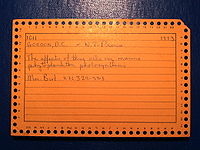
Edge-notched card
Encyclopedia

Edge-notched cards, or McBee cards, were a manual data storage and manipulation technology invented in 1896 and used for specialized data storage and cataloging applications through much of the 20th century. While there were many variants, a popular version consisted of 5 inch by 8 inch paperboard
Paperboard
Paperboard is a thick paper based material. While there is no rigid differentiation between paper and paperboard, paperboard is generally thicker than paper. According to ISO standards, paperboard is a paper with a basis weight above 224 g/m2, but there are exceptions. Paperboard can be single...
cards with holes punched at regular intervals along all four edges, a short distance in from the edges. To record data, the paper stock between a hole and the nearest edge was removed by a special notching tool. The holes were assigned a meaning dependent upon a particular application. For example, one hole might record the answer to a yes/no question on a survey, with the presence of a notch meaning yes. More complex data was encoded using a variety of schemes, often using a superimposed code
Superimposed code
A superimposed code such as Zatocoding is a kind of hash code that is popular in marginal punched-card systems.- marginal punched-card systems :Many names, some of them trademarked, have been used for marginal punched-card systems:...
. The center of the card might be blank space for information to be written, or contain a pre-printed form.
To allow a visual check that all cards in a deck were oriented the same way, one corner of each card was beveled, much like Hollerith punched card
Punched card
A punched card, punch card, IBM card, or Hollerith card is a piece of stiff paper that contains digital information represented by the presence or absence of holes in predefined positions...
s. Edge-notched cards, however, were not intended to be read by machines. Instead, they were manipulated by passing one or more slim needles through selected holes in a group of cards. As the needles were lifted, the cards that were notched in the hole positions where the needles were inserted would be left behind as rest of the deck was lifted by the needles. Using two or more needles produced a logical and function. Combining the cards from two different selections produced a logical or. Quite complex manipulations, including sorting
Sorting
Sorting is any process of arranging items in some sequence and/or in different sets, and accordingly, it has two common, yet distinct meanings:# ordering: arranging items of the same kind, class, nature, etc...
were possible using these techniques.
Before the widespread use of computers, some public libraries used a system of small edge-notched cards in paper pockets in the back of library books to keep track of them.

